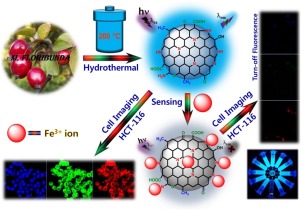Journal of Photochemistry and Photobiology A: Chemistry ( IF 4.1 ) Pub Date : 2019-12-20 , DOI: 10.1016/j.jphotochem.2019.112336 Raji Atchudan , Thomas Nesakumar Jebakumar Immanuel Edison , Suguna Perumal , Nallal Muthuchamy , Yong Rok Lee

|
In this work, green and economical synthesis of highly fluorescent nitrogen-doped carbon nanodots (N-CNDs) is reported using Malus floribunda (M. floribunda) fruit and aqueous ammonia as carbon and nitrogen source, respectively by a simple hydrothermal method. The synthesized N-CNDs show exceptional advantages including acceptable fluorescent quantum yield (18 %) and N-CNDs sizes are around 3.5 nm. The fluorescence of N-CNDs based nanosensor can be selectively and sensitively quenched by ferric ions in the aqueous medium. This phenomenon was used to develop a fluorescent method for facile detection of ferric ions within a linear range of 10–50 μM with a detection limit of 2.5 μM (S/N = 5) having linear regression value (R2) of 0.994. The synthesized N-CNDs incubated with human colon cancer (HCT-116) cells which did not stimulate cell death, indicating that the N-CNDs have good biocompatibility. Hence, the N-CNDs was used as a fluorescent probe for in vitro imaging of HCT-116.TheN-CNDswereuniformly internalized into the whole body of cells and displays the multicolor fluorescence imaging. To best of the authors' knowledge, this is the earliest report on the selective sensing of ferric ions and live-cell imaging using M. floribunda fruit-derived N-CNDs by fluorescent quenching mechanism.
中文翻译:

海桑(Malus floribunda)的可调谐荧光碳纳米点的生态友好合成,用于传感器和多色生物成像
在这项工作中,据报道,通过简单的水热法,使用苹果花(Malus floribunda)果实和氨水作为碳源和氮源,绿色环保地合成了高度荧光的氮掺杂碳纳米点(N-CNDs)。合成的N-CND具有优异的优势,包括可接受的荧光量子产率(18%),N-CND尺寸约为3.5 nm。基于N-CNDs的纳米传感器的荧光可以被水性介质中的铁离子选择性地和灵敏地猝灭。该现象用于开发一种荧光方法,用于简便地检测线性范围为R 2(R 2)的线性范围为10–50μM且检测限为2.5μM(S / N = 5)的三价铁离子。)的0.994。合成的N-CND与未刺激细胞死亡的人结肠癌(HCT-116)细胞孵育,表明N-CND具有良好的生物相容性。因此,N-CNDs被用作HCT-116体外成像的荧光探针.N-CNDs被均匀地内化到细胞的整个体内,并显示出多色荧光成像。据作者所知,这是关于利用荧光猝灭机制使用花枝多孢菌果实衍生的N-CNDs选择性检测铁离子和活细胞成像的报道。











































 京公网安备 11010802027423号
京公网安备 11010802027423号